>
EDELWEIS - p2: LIVING-SPACES >
>
EDELWEIS - p3: LIVING-SPACES - cont >
|
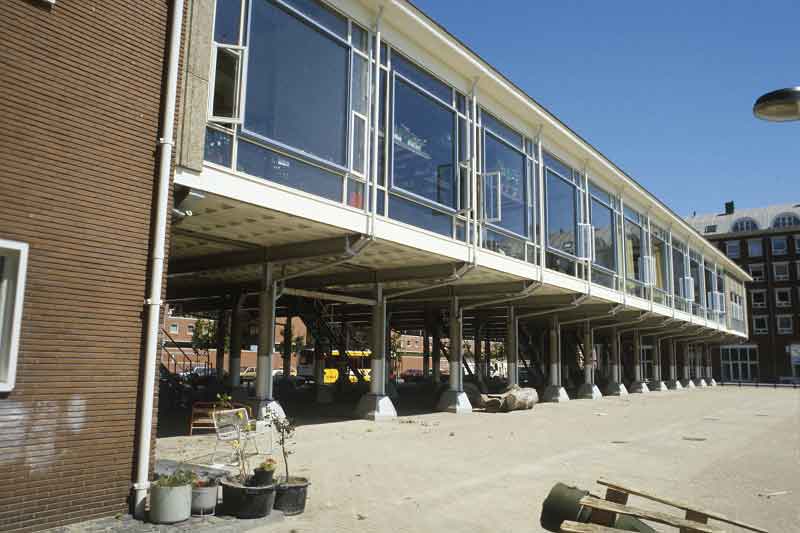 |
|
|
EDELWEIS
(STICHTING):
S-FACADE - RENOVATED BY THE COLLECTIVE OWNERS
(pic
8-95 / to NE)
|
.
EDELWEIS
INTRODUCTION
Edelweis is on KNSM Eiland, the most extreme
north-easterly of the branching flat peninsulas of the Eastern Docks (Havens
Oost). Seen across the Ertshaven water from the causeway approach-road it
visually commands, though small, the Eiland’s centre; its delicate glass
volume massively framed by huge new housing blocks, their late 80’s
‘sculptural’ assertiveness and their functional insensitivity strangely
outdated beside the clarity, poise and straightforwardness of the 30 year old
building.
This long flattish steel glass and concrete box
raised on rows of girder legs was designed and built between 1958 and 1962 as a
restaurant and theatre for the dock-workers. Its design-significance enabled it
to survive the 1987 demolitions and residential redevelopment of the Havens Oost.
Squatted by 6 artists on 8th Dec 1982 its long
volume was divided by low partitions into 6 studio spaces, bracketed at the
building’s ends by 2 extraordinary living-spaces. In 1987 it stood isolated on its promontory of empty sand (reflecting in
miniature the Eiland’s shape and axis), a squatted oasis with a fringe of
saplings and chickens. In 1991, surrounded by the mess of building-sites and
growing housing-blocks, Edelweis was bought from the City by its occupiers and
rented to themselves through a structure of interlocking organisations (a
“Stichting Edelweis” the legal 'Edelweis Company' owner, and a Vereniging or ‘Collective’
administrating finance).
From this point the building began to undergo a
fundamental change: in seven months of co-operation (from early ‘91) the eight
effected its structural transformation from a single open volume to a series of
closed cells; from a shared social/working place to a row of potential private
living-spaces each with its own entrance. They removed the hung-ceiling and
elephantine ducts of primitive air-conditioning, divided the building into
sections with cross-walls of cement-blocks (up to 4.5m, then Rockwool-insulated
plasterboard), made minimal changes to the framing of the glass walls to
accommodate hinged casements (the enormous glass sheets necessitating a
professional glazier), cut extra windows for two apartments in the building’s
brick and concrete-clad ends, and - since fire regs required separate exits -
invented a means of access for the 6 new apts with no existing stairs: a
dry-dock demolition affording 6 cheap steel ladders almost all of which (with
the bizarre precision typical of improvisatory discoveries) fitted exactly the
gap between the diamond-sawn holes in the building’s belly and the ground. To
comply with the City’s interest in its historical status all the changes to
the building’s external appearance were ‘architect-approved’.
In its new ‘row-housing’ role Edelweis
constitutes 8 apartment spaces. Seven occupy the raised ‘slab’ of the
restaurant/kitchens/stage. Five are of identical shape and cubic volume, each a
transverse segment the width of two window-bays, cut by the new cement-block
walls across the glazed portion of the building. At each end of this ‘row of
5’ is a space that is continuous in level and roughly equal in volume, but
otherwise differs: the one at the east end is enclosed behind exterior concrete
cladding-panels in what was the stage and its ancillary rooms (and thus is
graced with its own glazed entrance porch and stair); the one at the west end
utilises the last remaining window-bay and has an asymmetrical plan, extending
through the concrete-clad old kitchens to the north side of the front facade,
wrapping in an ‘L’ the offset rectangular block of the old entrance-foyer
and stair. This latter is virtually a separate brick-clad glass-fronted
two-storey building embedded in the slab - it contains the most complex and
isolated of the 8 apts. As a space for living in it is unlike any of the others:
the encumbrance of massive forms associated with the building’s access forced
on it the most radical adaptation.
Though the work of conversion was co-operatively
shared, the inside of each living-space is the invention of its occupier. Each
(except the special case of the foyer) began as an empty volume the size of a
large two-storey suburban detached house: a 3D tabula rasa for life-style
improvisation and display. Eight still-evolving expressions of individualism
protected within a collective administration.
The
mechanistically fair dividing of Edelweis has forced most of its apt makers to
‘express their conceptions’ in a set of uniform containers, which by
emphasising individuality makes it seem a kind of ‘exhibitionism’. From the
now paved plaza the raised building displays its contents like a huge showcase -
the astonishingly various constructions of the apartments glimpsed through their
glass walls, mixed with reflected clouds - a ‘ceremonial presentation’ to
the surrounding teeming city of an alternative and self-invented life ...
exemplars of luxurious individualism, aristocratic initiative and
self-sustenance!
|
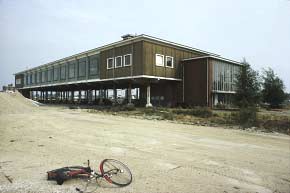
|
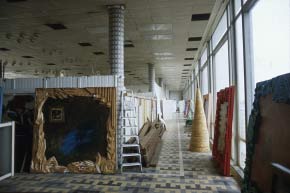
|
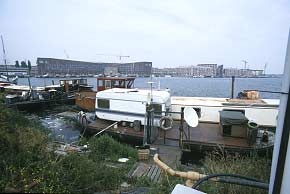
|
|
EDELWEIS
(SQUAT)
(pic
9-90 / to SE)
The
Edelweis dock-workers' restaurant/theatre was almost the only building
saved from demolition of the KNSM Eiland dock facilities.
|
EDELWEIS
(SQUAT) - INTERIOR STUDIOS
(pic
9-90 / to E)
The
building’s long elevated volume viewed from the former restaurant’s
entrance. Makeshift walls claim and screen individual studio spaces. Foreground art-works are Leonie’s (just returned from
exhibition). (The photo was taken just before the meeting which decided to
buy Edelweis.)
|
EDELWEIS
(STICHTING) - ON REBUILT KNSM
EILAND
(pic
9-94 / to NE)
Seen
across the Ertshaven from the south end of the Verbindingsdam causeway,
Edelweis is embedded in the enormous
KNSM Eiland housing development.
|
|
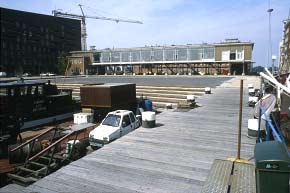
|
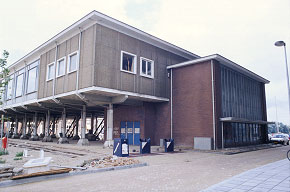
|
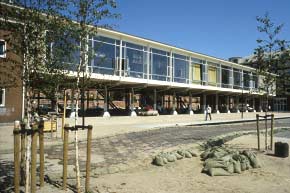
|
|
EDELWEIS
(STICHTING) - S FACADE FROM DOCK
(pic
9-94 / to NNE)
|
EDELWEIS
(STICHTING) - NW CORNER
(pic
9-94 / to SE)
The
entry block (Henk's living-space) is partly embedded in the SW corner of
the main pilotis-supported building.
|
EDELWEIS
(STICHTING) - S FACADE
(pic
8-95 / to NNE)
Recently
embedded in a new housing suburb and now straddling a public water-front
plaza, Edelweis has just been renovated (to its original 1958 colours), by
the eight artist-owners (most of them its ex-squatters).
|
|
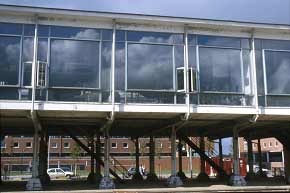
|
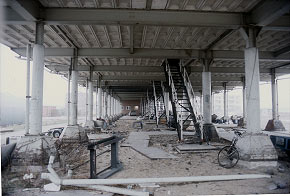
|
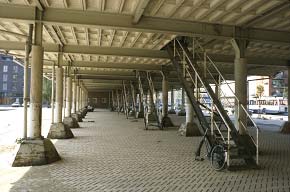
|
|
EDELWEIS
(STICHTING) - S FACADE
(pic
9-94 / to N)
From
the left: the first two windows are Gerard's (centre apt in the 'row of
5'), the next two Godelieve's, the last Leonie's.
|
EDELWEIS
(STICHTING) - APT ENTRY STAIRS
(recovered
pic 1-92 / to W)
The
underside of the building soon after it was bought and divided into separate
living spaces, but before the new Stichting renovated it. Fire
regs insisted that each living-space had independent access. Six
dock-demolition
stairs were bought cheap and most fitted exactly! Diamond-sawn holes
were made through the building's three floor-layers: concrete-panels /
insulation / tiled floor.
|
EDELWEIS
(STICHTING) - APT ENTRY STAIRS
(pic
9-94 / to W)
The new housing-suburb's plaza now extends under the building
|
.
^ Top
> Next Page >
EDELWEIS - p1: INTRO
>
EDELWEIS - p2: LIVING-SPACES >
>
EDELWEIS - p3: LIVING-SPACES - cont >
.









